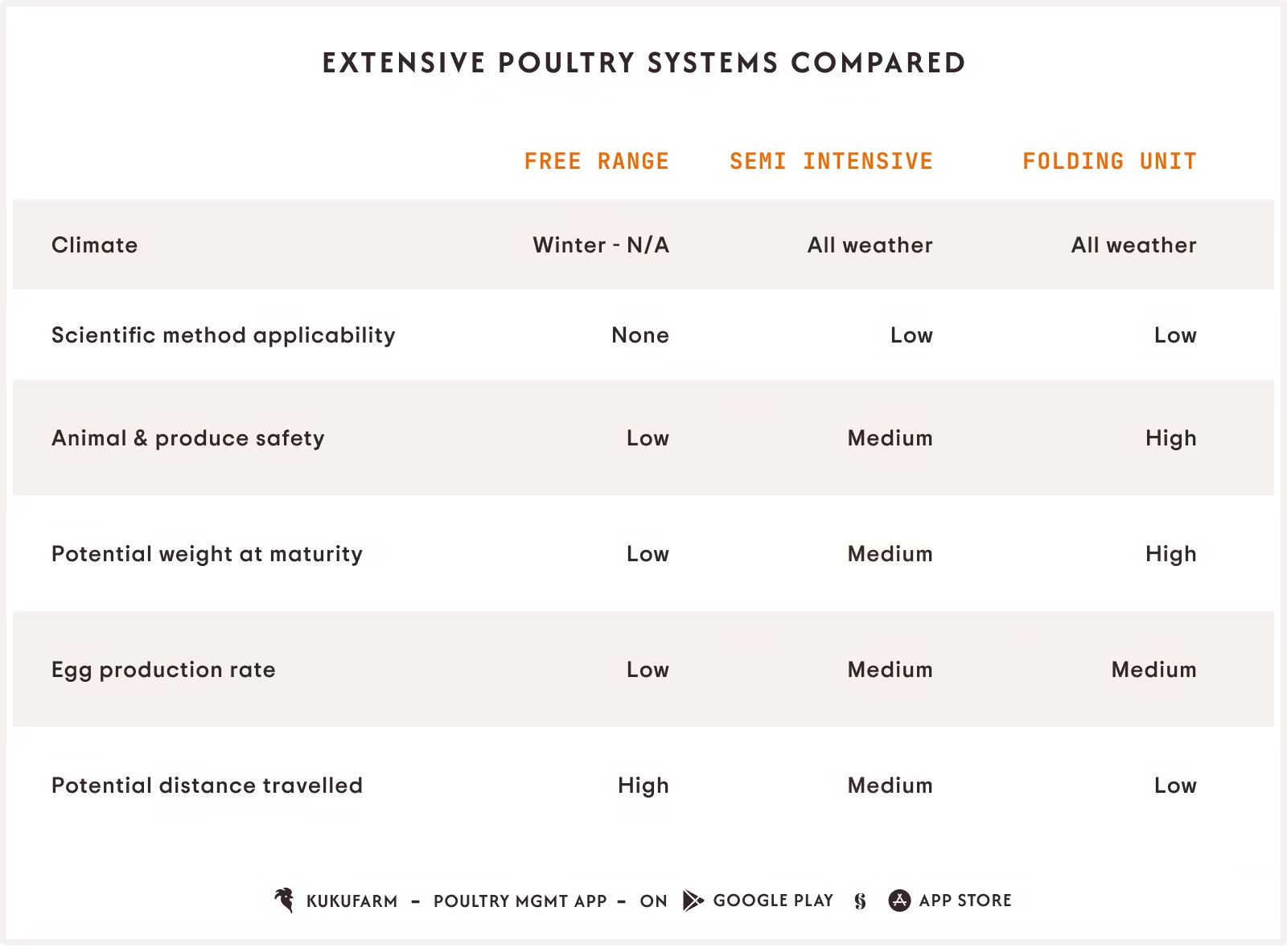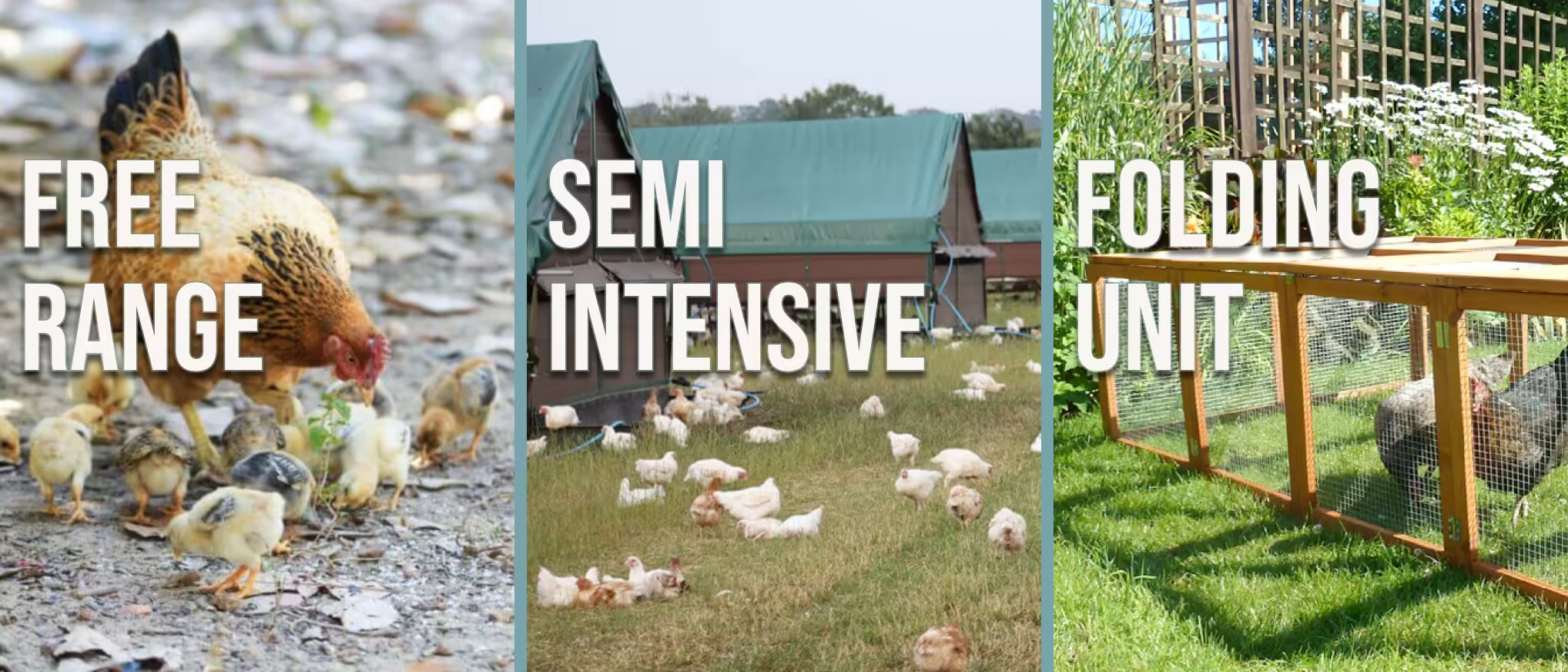Extensive poultry systems have recently become popular with the rise of animal welfare concerns and the backlash of factory farming, among other things.
There are 3 poultry systems categorised under extensive poultry systems. In contrast, there are 5 systems under intensive poultry systems. In total, there are 8 poultry housing systems.
Extensive poultry housing systems include:
- Free range
- Semi intensive
- Folding units, also known as mobile units
In this article, we will look at the characteristics of extensive poultry and compare them. Meanwhile, you may be interested in how to choose the most suitable poultry system, or organic poultry farming.
You may also be interested in our comparison of organic vs. conventional poultry farming.
What is a poultry system?
Simply put, a poultry system, or poultry housing system refers to the flock management method you use in raising your flock.

Some factors that determine poultry system type include:
- Feed type – e.g. pasture vs. processed feeds
- Living surface – e.g. deep litter, slatted floor, etc
- Affordance to movement – e.g. free range, cages
- Access to outdoors and pasture – e.g. extensive vs. intensive
Besides these basic differences, poultry systems also differ by flock performance. For instance, F.X. Phillippe et. al. have shown that cages have higher egg production rate than aviary systems. Naturally, extensive systems can also be expected to have lower egg production rates than intensive poultry systems.

It is also our opinion that some poultry breeds perform better in specific poultry systems. Therefore, if you opt for an extensive poultry system, you have to select a breed that performs well in such a system for best outcomes. In addition, if you are detail oriented, you can have a look at A review of 20 years of scientific research: The right chicken for the right system.
3 Extensive poultry systems
The overarching feature of extensive poultry systems is that they afford poultry birds access to outdoors. Such access is not merely for feeding purposes but also for exposure to sunlight, and other animal welfare considerations.
Importantly too in extensive poultry systems, you have to implement effective predator control and manage environmental conditions to keep your flock safe and stress free.
1. Free range
Fundamentally, in a free range poultry system you allow your flock to spend their day outdoors primary for grazing, while providing shelter at night. This poultry system promotes natural behaviors and enhances animal welfare.
Additionally, as with other extensive systems, free-range birds enjoy a more diverse diet, improving the quality of their eggs and meat.
2. Semi intensive
In general, semi-intensive systems, combine elements of free-range and conventional poultry housing.
In this type of poultry system, you allow your birds access to outdoor areas for foraging. However, the flock spends part of its time in an intensive system. Furthermore this also means that while your birds may forage and graze outside, you can feed them processed feeds while they are indoors.
3. Folding / mobile units
Typically, folding or mobile units come in different forms and sizes. Fundamentally, they consist of a movable coop, which is referred to as a folding or mobile unit, because it is built to be moved.
In other words, a folding unit is a portable housing structure ideal for both small and large flocks. These mobile units allow you to relocate your birds to fresh areas, enabling them to forage in new pastures regularly.
Extensive poultry systems compared
Poultry systems could be compared against several factors including egg productivity, applicability of scientific methods, and so on.
However, extensive systems appear closely matched on a number of factors so it is not easy to conclusively say one is better than the other. For instance we think set up costs and land requirements are closely matched depending on whether you raise a small or big flock.
Nonetheless, we can say a few words on factors such as climate and scientific farming, safety, and flock productivity.
Weather and climate
We see the applicability of free range and folding unit to be limited to tropical climates. That is because if winters get particularly cold, there will be no pasture for your birds outside. Moreover, that being the case, letting them outside when it is freezing will be a bad idea in itself.
Scientific method
Intensive poultry systems are basically built to suit the application of scientific farming methods. That is, you can control for instance coop climate, the amount of food birds consumer, and the amount of movement they have, among other things.
In extensive systems, the scientific methods are less applicable. This is not a bad thing since what you lose, you gain in terms animal welfare aspects. In extensive poultry systems, your flock can freely engage in natural behaviours, eat a more diverse diet and so on.

Productivity and health
Our assumption is that the free range system may have the lowest egg production rate and lowest overall animal weight gain. That is because if your birds move around a lot, they end up spending their energy and have less reserves left for egg production and weight gain.
How semi intensive and folding unit may compare we are not sure. However, since we are already making guesses, we might as well do so. Folding unit might be most productive in all aspects since birds movement can be limited.

Furthermore, since you can feed your birds in both folding unit and semi intensive, they are likely to out perform free range birds by some margin. According to Bosco et. al. fast growing poultry breeds not suited for extensive poultry systems.
Animal and produce safety
Since the premise of extensive poultry is to allow animals access to the outdoors, the safety of your birds and produce comes into question. In other words, how safe are your chicken and their eggs in the 3 extensive systems.
Obviously, free range is the most risky system since birds roam freely without explicit protection from predators. You are also likely to lose eggs laid in the fields, if your hens wander far and wide.
Semi intensive system can be semi safe since in theory you can allow your birds outside in the afternoon hours and in so doing, have them lay eggs inside the coop. However, a folding unit in regard to animal and produce safety is the safest of all three. That is because your flock is always protected, from the elements, from predators and you can be sure to find all your eggs.
*
Fundamentally, extensive systems are intended at improve animal welfare, productivity quality and environmental sustainability. For these reasons, you cannot fully appreciate the beauty of extensive poultry systems without comparing them to intensive systems. For your benefit, we’ve done that comparison in another article.
How to choose a suitable poultry system
The million dollar question that you have to ask yourself is what type of poultry system is best for you. In our opinion, it boils down to your resources, personal preferences and local regulation. For instance,
- Do you have access to pastures or are limited to a small space?
- Are you raising commercial birds or for own consumption?
- What poultry systems are permitted in your region?
- Do you want to raise birds organically or conventionally?
- Is scientific farming method your thing?
- Are you looking for a system that is automate-able?

Answering these kinds of questions will enable you to choose a poultry system best suited for your needs. To get you started, here are our thoughts on how to pick the best poultry housing system. For your interest, we’ve also done some poultry system comparisons:
- Deep litter vs. slatted floor
- Free range vs. Deep litter
- Deep litter vs caged poultry systems
- Cage systems vs. aviary
- Deep litter vs Aviary poultry systems
- Cage vs slatted floor poultry systems
- Free range vs caged poultry systems
- Cages vs aviary systems
- Extensive VS Intensive poultry systems
- Intensive poultry systems compared
- Which poultry system is better for poultry health and welfare?
- A quick look at the furnished cage poultry system
- 10 Reasons why poultry farming fails and how to avoid them

